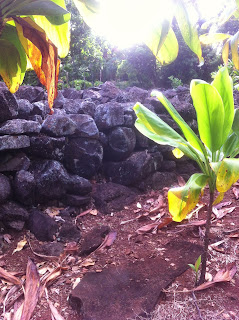Pronounced Ke-ai-wa, this heiau was rediscovered in 1951. Thrum noted that it was created in the time of Kakuhihewa and it's priest was named Keaiwa. Anthropologists were at a loss when first trying to discern the use of this heiau. A local from Aiea, Paul Keliikoa knew of it from his grandmother Kamoekai. She exclaimed that Keaiwa meant "a period of fasting and meditation." As the priests would spend most of their time doing so. Novice Kahuna Lapaau were brought here to learn the art of healing and then sent to other places to apply what they have learned. Native plants associated with healing practices would have been growing just outside of the heiau.
I myself have always visited this heiau since I was little. I remember my first time was when my late uncle Kalani completed two go carts and we all came up here to test them out on the curved roads above the heiau. My dad would always come here to ease his mind. He even brought home a rabbit he found, that we kept as a pet. Once he came home with a small rock with a face on it. My mom and I knew the rules about that and eventually we got him to return it...
A couple of days ago I had some free time and energy to take a ride up to the heiau. I decided to approach it with a clear mind and try to see things for myself. I began with walking around the perimeter of it from the north wall and around counterclockwise.
Here is a flat stone like no other outside of the heiau terrace. Later I found another on the inside that lined up with this one on the opposite side.
Here is a view looking south into the heiau from the location of the flat stone outside. When the heiau was rediscovered, only that small wall inside was recorded. All of the other structures inside, were not or were added later. The height of the inner wall was said to have possibly divided the heiau into two sections and was only about a foot in height. Now it's about three feet high. The heiau itself is considered of a single terrace construction at one unifying level.
Continuing west around the northern wall are a few circular stones piles.
Here I am viewing from the western wall. This wall was in the worst condition at rediscovery and was crumbling into the heiau, covered in sediment from the hill above it.
I found this stone with a sharp edge at what would be the top center outside of the heiau. Behind it are some ti plants and noni growing.
Here is a very curious looking corner of the heiau in the southwest section. This was suspected as the entry point by the study of the heiau.
Here is a somewhat paved path that could have led to the suspected entry point of the heiau from the south.
Ulu stumps are to be found within and outside of the heiau structure...
Here is a thriving Ulu tree shading the southern wall of Keaiwa and a very old looking ti plant. This ti tree has a stone perimeter marking it's importance and it's wrinkly leaves indicate it as a Kahuna ti plant, as some may call it.
I thought this stone inside the heiau looked pretty cool with it's eye. Reminds me of Tobi from Naruto. Nothing like the stone my dad found when I was little though. I wonder where he put it...
two stone circles are located inside the heiau on both sides of the inner wall. Another with a grassy center is in the center of the larger section of the Heiau. They are of modern construction although the stone must have been used from the original structure. I remember my friends telling me they felt weird while standing inside the grassy centered one. I think I even sumo wrestled someone in it when I was younger.
I'm a little torn about offerings being left at historical sites...
Here I am looking at the western wall now opening up to another section of the heiau now.
Another Ulu stump inside the heiau.
These stones look very well placed compared to the rest of the placement of stones throughout the heiau.
Here is a very flat surface at what would be the entry level of the heiau.
Here is a paved slope leading into the heiau gradually.
Here is the flat stone that was similar to the one in my first image. This one is inside of the southern wall.



















No comments:
Post a Comment